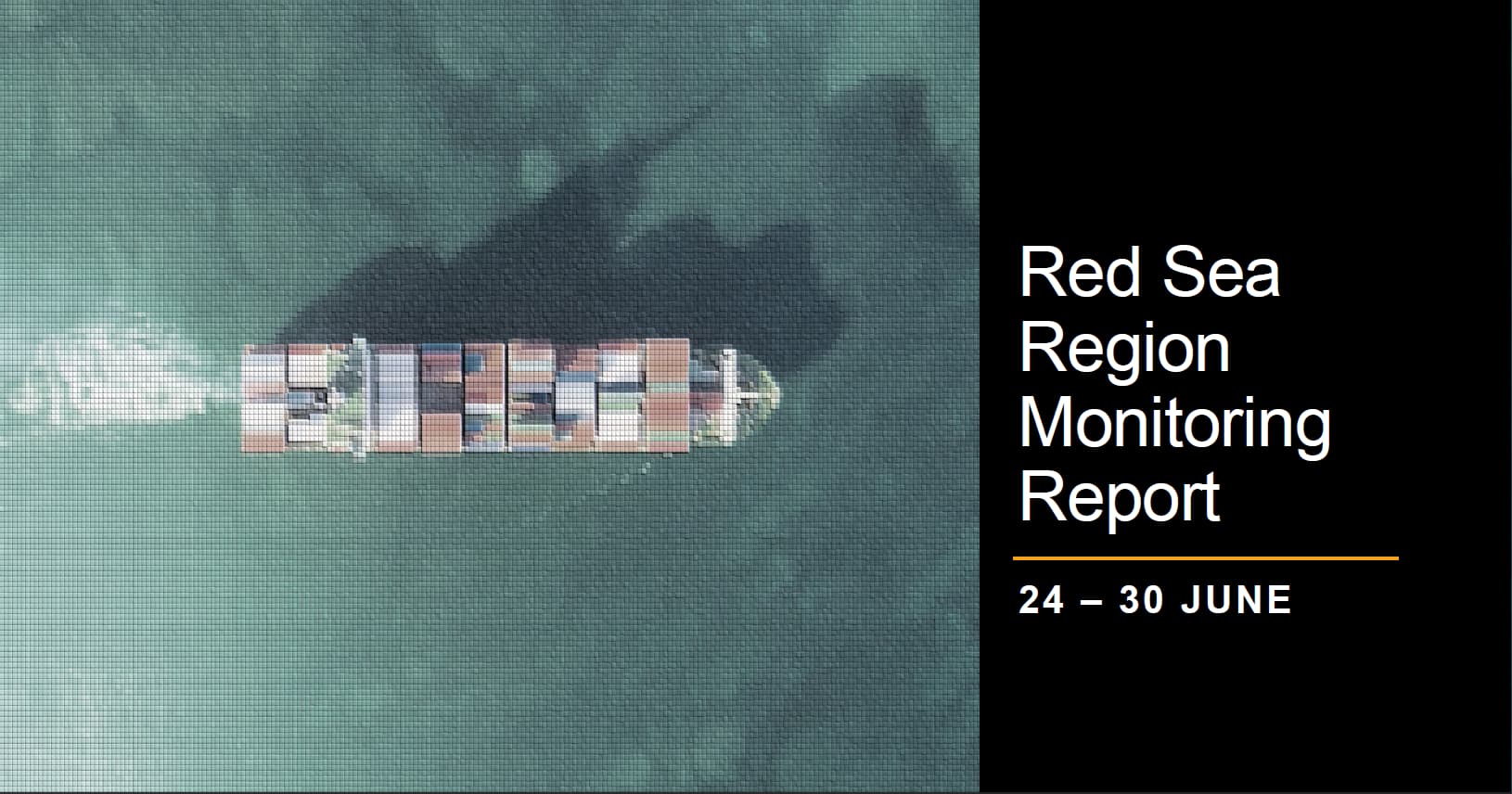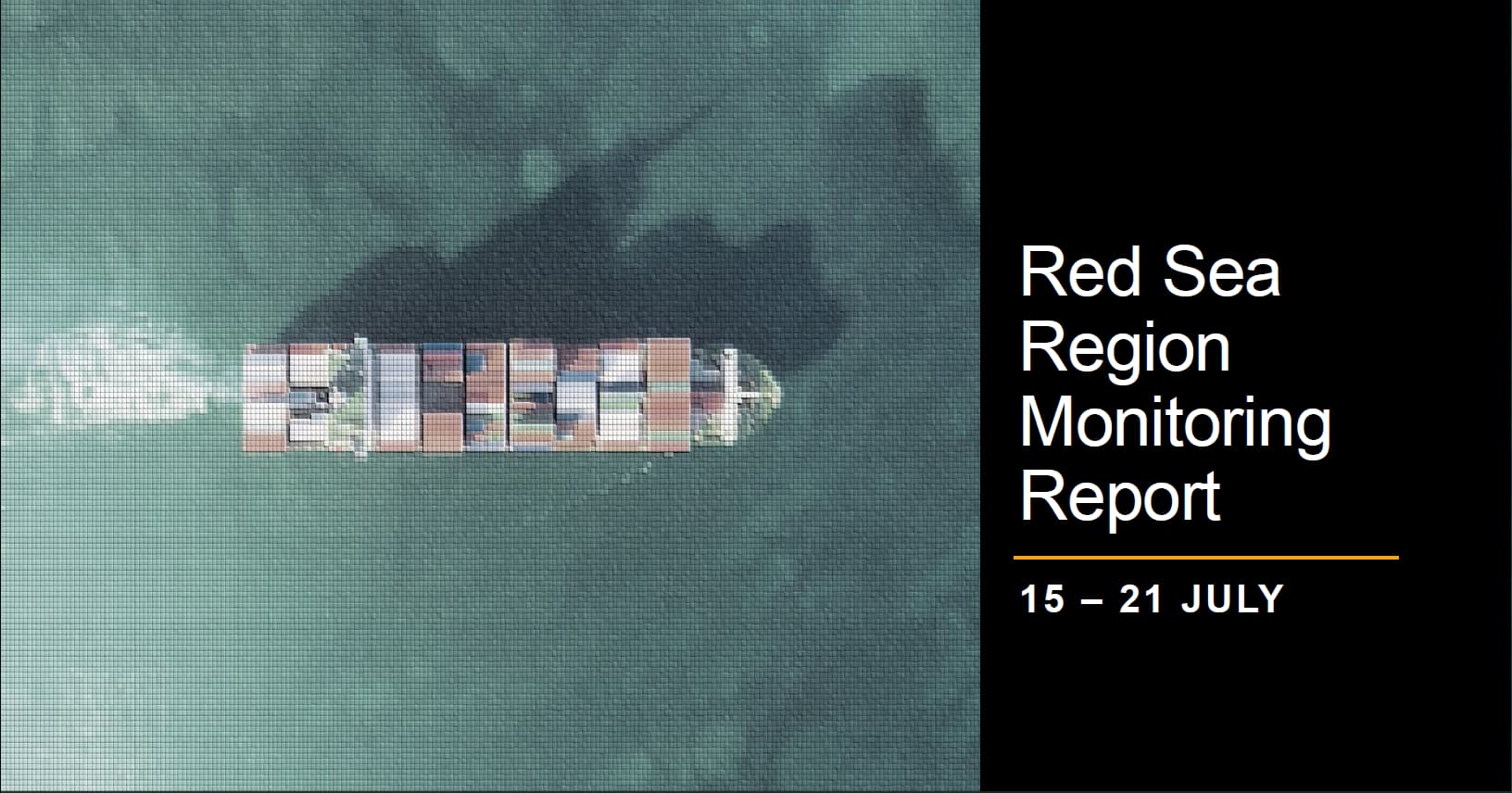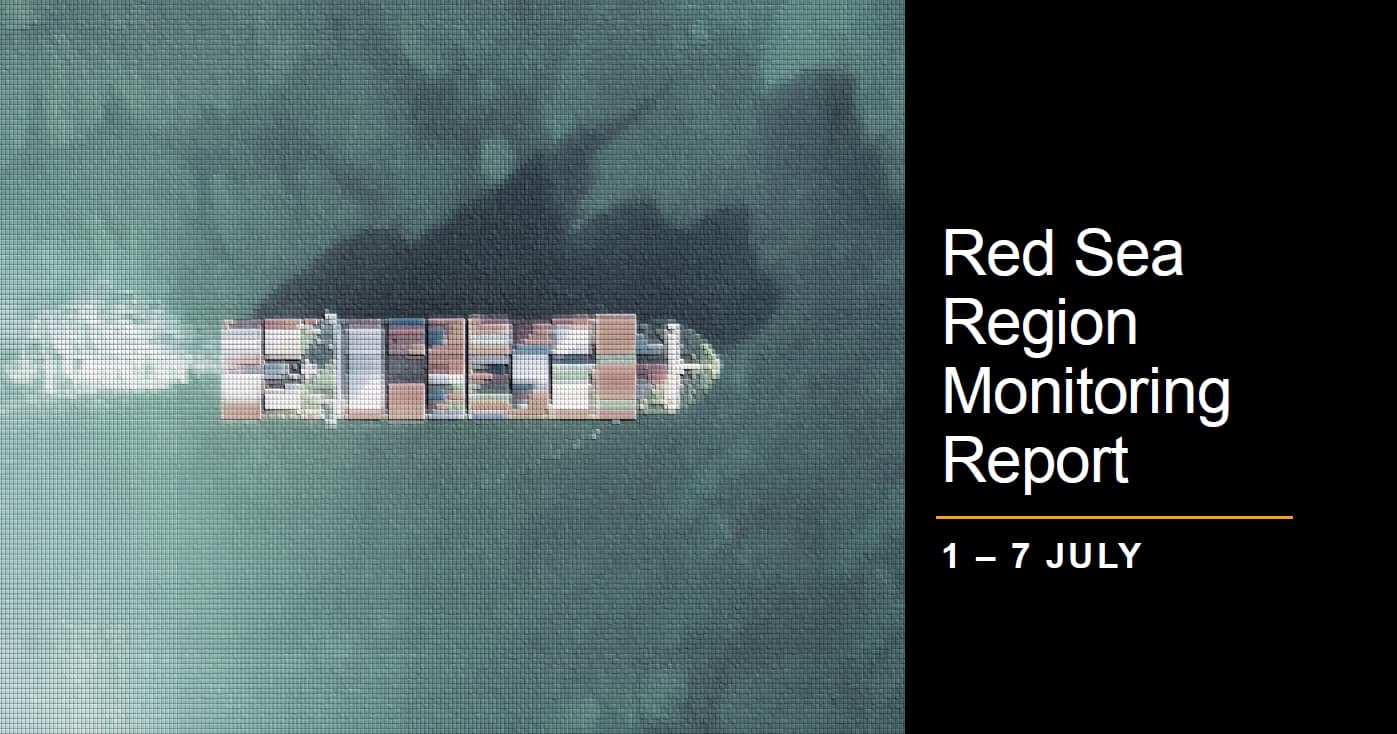KEY DEVELOPMENTS – COMMERCIAL INCIDENTS
During the monitoring period 19-25 February Regal Maritime Solutions (RMS) identified the following incidents in the Red Sea and Gulf of Aden region, obtained from a variety of open sources including UKMTO and the United States (US) military:
MISSILE STRIKE: On 19 February it was reported that the crew of the UK owned, Belize flagged MV Rubymar had abandoned the vessel with military assistance following a missile strike by Houthi militants on 18 February,tely 35NM south of Al Mukha, Yemen. All crew were reported safe.
MISSILE STRIKE: On 19 February, the MV Sea Champion reported an explosion in close proximity to the vessel approximately 100NM east of Aden, Yemen. This was followed shortly after by a second explosion which had struck the vessel resulting in superficial damage. The ship reported no injuries and continued onto its next port of call.
SUSPICIOUS ACTIVITY: On 19 February, two Unmanned Aerial Vehicles (UAVs) were identified following a commercial vessel approximately.90NM west of Jizan, Saudi Arabia. The UAVs proceeded to follow the vessel for around 30 minutes at a height of approximately 100 metres before departing the area.
UAV STRIKE: On 19 February, the MV Navis Fortuna was reportedly hit by UAV whilst approaching the Bab al-Mandab strait from the Gulf of Aden, 60NM north of Djibouti, resulting in superficial damage to the accommodation superstructure. The crew were reported safe and the vessel proceeded to its next port of call.
MISSILE STRIKE: On 21 February an explosion and flash was sighted in the southern Red Sea approximately 40NM west of Hudaydah. Vessels and crew in vicinity of the incident were reported safe.
MISSILE STRIKE: On 22 February two missiles impacted the MV Islander, a Palau-flagged, UK owned vessel approximately 70NM south east of Aden resulting in a fire on board. Coalition forces responded to the incident and confirmed the vessel sustained minor damage but the crew and vessel were safe and continued onto its next port of call.

KEY DEVELOPMENTS – MILITARY ACTIVITY
During the monitoring period 19-25 February RMS identified the following incidents involving US coalition forces in the Red Sea and Gulf of Aden region, obtained from military and open sources:
MISSILE STRIKE: On 19 February between 1230 and 1350 local time, two anti-ship ballistic missiles (ASBM) were launched from Houthi-controlled areas of Yemen toward MV Sea Champion, a Greek-flagged, US owned grain carrier in the Gulf of Aden. One of the missiles detonated near the ship causing minor damage, and no injuries to the crew. The ship continued toward its scheduled destination which was to deliver humanitarian aid to Aden, Yemen.
MISSILE INTERCEPT: On 19 February at approximately 1700 local time US naval forces located and destroyed a surface to air missile launcher in Houthi controlled areas of Yemen.
MISSILE ATTACK: On 19 February at approximately 1840 local time an anti-ship ballistic missile (ASBM) was identified as having been launched, but did not impact any commercial or coalition ships.
MISSILE STRIKE: On 19 February at approximately 1920., a one-way attack (OWA) unmanned aerial vehicle (UAV) struck the M/V Navis Fortuna, a Marshall Islands-flagged, US-owned, bulk carrier around 100NM north of Djibouti as it approached the Bab-al-Mandab to enter the Red Sea, causing minor damage and no injuries to the crew. The ship then continued its voyage toward Italy.
UAV INTERCEPT: On 19 February at around 2015 local time US naval forces launched a pre-emptive strike and destroyed a OWA UAV in Western Yemen which was prepared to be launched at vessels in the Red Sea.
UAV INTERCEPT: Over the course of the night 19-20 February between 2000-0030 local time coalition aircraft and warships shot down 10 one way attack (OWA) UAV in the Red Sea and Gulf of Aden after presenting an imminent threat to shipping in the region.
MISSILE INTERCEPT: On 20 February at approximately at 0030 local time US warship, the USS Laboon identified and struck an anti-ship cruise missile (ASCM) headed in its direction.
UAV/MISSILE INTERCEPT: On 21 February at around 1845 local time US forces conducted four pre-emptive strikes against seven mobile Houthi Anti-Ship Cruise Missiles (ASCMs) and one mobile Anti-Ship Ballistic Missile (ASBM) launcher that were prepared to launch towards the Red Sea. US forces also identified and shot down a one-way attack UAV.
UAV INTERCEPT: On 22 February between 0430 and 0530 local time coalition aircraft and warship shot down six Houthi one-way attack (OWA) UAVs in the Red Sea. The UAVs were likely targeting coalition warships in the area and deemed an imminent threat.
MISSILE STRIKE: On 22 February between 0830 and 0945 local time, two anti-ship ballistic missiles (ASBMs) were launched by Houthi militants from southern Yemen into the Gulf of Aden, impacting the MV Islander, a Palau-flagged, UK owned vessel causing one minor injury and damage to the vessel. Despite the impact the vessel was able to continue with its voyage.
UAV/MISSILE INTERCEPT: On 22 February at approximately 1700 local time US forces conducted pre-emptive strikes against four Houthi unmanned aerial vehicles (UAVs) and two mobile anti-ship cruise missiles (ASCM) that were prepared to launch from Houthi-controlled areas of Yemen towards vessels in the Red Sea.
UAV INTERCEPT: On 23 February between 0330 and 0500 local time US forces shot down three Houthi one-way attack UAVs approaching several commercial vessels transiting the Red Sea. There was no reported damage to any of the commercial vessels.
MISSILE INTERCEPT: On 23 February US forces identified and destroyed seven Houthi mobile anti-ship cruise missiles (ASCMs) that were prepared to launch towards the Red Sea and considered an imminent threat to commercial and coalition warships in the area.
MISSILE INTERCEPT: On 24 February at approximately 1700 local time, US warship, the USS Mason identified and shot down one Anti-Ship Ballistic Missile (ASBM) launched into the Gulf of Aden from Houthi controlled areas of Yemen. The ASBM was likely targeting MV Torm Thor, a US flagged, owned, and operated chemical/oil tanker. Neither the USS Mason and MV Tom Thor was damaged in the incident nor their crew injured.
COORDINATED MILITARY ACTION: On 24 February US and UK military aircraft conducted strikes on Houthi sites in Yemen, in its fourth such joint operation. The coordinated action targeted approximately 18 sites across eight locations, directed against underground weapons storage facilities, UAVs, air defence systems, radars and a military helicopter.
Intelligence successfully identified several long-range UAVs, used for both reconnaissance and attack missions at a former surface-to-air missile battery site several miles north-east of Sana’a according to the UK Ministry of Defence. The strikes were carried out with support from Australia, Bahrain, Canada, Denmark, the Netherlands, and New Zealand.
US and UK forces reportedly conducted three airstrikes on a pesticide factory in the Al-Nahda neighborhood of Al-Thawra district, six airstrikes in the Attan area, and three Al-Nahdain area of the capital, Sana’a. A further two airstrikes were reported on Jabal Aram in Hamdan, and three in the Sarf area in Bani Hushaish, Sana’a governorate. Two airstrikes targeted the communications network in the Qaradha area of Haifan district and another on the communications network in the Shamir area of Maqbanah district in the Taiz governorate, which reportedly killed on civilian and injured six others according to local sources. Meanwhile, two airstrikes were reported on Al-Jar farms in Abs district, Hajjah governorate.
The strikes were aimed at further degrading Houthi capabilities following sustained attacks by the group on the Red Sea trade route over the past week in addition to the targeting of coalition warships. In a joint statement, the US and UK confirmed the action and acknowledged that more than 45 attacks on commercial and naval vessels have occurred in the region since mid-November.
UAV INTERCEPT: On 25 February at approximately 2100 local time US forces identified and shot down two one-way attack UAVs over the southern Red Sea in self-defense. A third UAV crashed in what was believed to be a result of an in-flight failure.

KEY DEVELOPMENTS – HOUTHI MISSILE STATISTICS

Figures 1 and 2 identifies the number of missiles, UAV, USVs and UUVs launched, or prepared to be imminently launched, by Houthi militants from Yemen targeting both commercial and naval vessels in the Red Sea and Gulf of Aden regions from data available from UKMTO, the US military and OSINT sources. Both figures have incorporated statistics from vessels hit, near misses and pre-emptive strikes on-land in Yemen by US-led Coalition forces but not those resulting from large scale coordinated military action. In some cases the destined target of Houthi weapons destroyed on-land in Yemen cannot not be verified and has therefore been categorized as ‘Not Known’ (NK). Where no dates are provided there were no reported incidents or data available for that period.

REGIONAL DEVELOPMENTS
During the monitoring period 19-25 February RMS identified the following key regional developments:
A study conducted by the US Defence Intelligence Agency (DIA) confirms consistent comparisons between Houthi launched UAVs used to target commercial and navy warships in the Red Sea and Gulf of Aden with those used by the Iranian military.
On 19 February the crew of the British flagged vessel Rubymar abandoned ship following a missile attack on 18 February, some 35NM from the Yemen coast. The attack occurred despite US naval strikes over the weekend 17-18 February targeting Houthi sites which claimed to have reduced Houthi capabilities.
On 19 February Yemen’s Houthi military spokesman Yahya Sarea announced it had shot down a US MQ9 UAV in the port city of Al-Hudaydah after claiming it had successfully struck the UK-owned cargo ship Rubymar off the coast of Yemen, leaving its crew scrambling to “abandon the vessel” after causing “catastrophic” damage.
The EU Naval Force (EUNAVFOR) Operation ASPIDES was inaugurated on 19 February with the mandate to accompany vessels in the Area of Operation; ensure maritime situational awareness in the Area of Operation; Protect vessels against multi-domain attacks at sea, in full respect of international law, including the principles of necessity and proportionally, in a sub-area of the Area of Operation. Operation ASPIDES will act in line with the UN Security Council Resolution 2272, which demands Houthis to cease all attacks on merchant and commercial vessels and notes the right of to defend vessels against such attacks, in line with international law and will not conduct any strikes on land. The operation will consist of four navy frigates and one aerial asset.
On 22 February the US Biden administration warned Iran of a “swift and severe” response from the international community should it provide ballistic missiles to Russia. The statement follows earlier media reports in the week that Iran had shipped such weapons to Moscow, which the US is yet to see such evidence. Such an action could potentially escalate tensions in the region further.
On 24 February US and UK military aircraft conducted strikes on Houthi sites in Yemen, in its fourth such joint operation. The coordinated military action targeted approximately 18 sites across eight locations within Sana’a and its surrounding regions. The strikes targeted underground weapons storage facilities, UAVs, air defence systems, radars and a military helicopter. The strikes were aimed at further degrading Houthi capabilities.
On 25 February Houthi militants confirmed its naval forces carried out a direct military operation targeting the US vessel “Torm Thor” in the Gulf of Aden with a number of naval missiles. This was a coordinated action which also saw the group target coalition warships in the Red Sea with a number of UAVs.
Negotiations for a new hostage deal between Israel and Hamas took place in Paris on 24 February. Despite some progress being made after Hamas dropped some of its demands, Israeli negotiators indicated that a breakthrough remains some distance, despite optimism by other international parties. The negotiations involving the US, Qatari and Egyptian officials aims to negotiate a hostage release in exchange of a ceasefire with the hope of heading off an Israeli assault on the Gaza city of Rafah where more than a million displaced people are sheltering. A mid-level Israeli delegation is in Doha to continue working on the details of a potential agreement that would see dozens of hostages released in exchange for an extended truce in the conflict.
Whilst China has so far remained somewhat muted and distant from the US led strategy on the addressing the security situation in the Red Sea region, considered an important maritime lifeline to its ongoing economic and political ambitions, it has been engaging unilaterally with key regional actors in an attempt to resolve the crisis. China has reportedly lobbied Iranian officials to dissuade the activities of Houthi militants in the Red Sea, which has so far had little effect. Nonetheless, China continues to remain in close communication with parties concerned in an effort to de-escalate the situation, whist requesting the cessation of harassment against commercial shipping and urging all parties to stop fuelling the tensions.
The Israel-Hams conflict and the Houthis support for Gaza via its attacks on commercial vessels in the Red Sea region has resulted in a recruitment surge for the group. With estimates of approximately 150,000 new members joining as of mid-February., there is concern there will be a greater political shift in favour of the Houthis, thus changing the political landscape of the country, and potentially wider region considering its close affiliation to Iran and strategic geographical placement on the Red Sea maritime transit route.
Iran has launched its own diplomatic effort in an attempt to disrupt and halt US and UK attacks on the Houthi militant group in Yemen, with its foreign ministry emphasising that the events presented in the Red Sea region is a consequence of the Israel-Hamas conflict in Gaza. It claimed that such attacks violate the sovereignty of an independent and United Nations (UN) member state., claiming the actions as illegal. The Iranian Foreign Ministry also stated the deaths of Iranian Republican Guard Corp (IRGC) officers in Syria last month during US strikes would not go unanswered.
The Iranian Behshad intelligence collection vessel is located in the vicinity of 32NM north east of Lughaya, Somalia at the time of this report.
ASSESSMENT
Houthi attacks will continue in the region and continue to impact global supply chains resulting in continued major disruption and rising costs for shipping companies.
Iran will continue to smuggle weapon components to Houthi militants via shipping vessels and through arms smuggling networks within the territory controlled by Yemen’s internationally recognised government.
The US and its partners will continue to conduct pre-emptive strikes and large scale coordinated military strikes against Houthi targets on-land, as the US led coalition continues to seek ways to degrade Houthi capability.
The US will continue to proactively attempt to identify vessels suspected of smuggling weapon components from Iran to Houthi militants in an attempt to stem the flow of such technology used in the targeting commercial shipping in the region.
Houthi militants may become more reliant on one way attack UAVs. Assembly facilities used to manufacture such weapons are spread across the northwest territory underground and in densely populated areas making them harder to target by US coalition forces.
Military strikes and counter-strikes across the region between Israel, the US, Iran and its regional proxies is likely to continue to escalate via tit-for-tat retaliatory measures, whilst attempting to prevent direct conflict between key powers.
The US government will continue to pursue a diplomatic solution for the Israel-Hamas conflict with regional partners as well as seek ways to mitigate the potential of wider conflict.
Houthi attacks will likely see a significant reduction or cessation in the event of a negotiated ceasefire between Israel and Hamas. However the long term threat posed to commercial shipping from the group in the region will very likely remain.
Despite Iranian Foreign Ministry rhetoric, sources indicate that Iran has adopted a more measured tone in private with its proxies such as Hezbollah and Iraqi militias as to prevent further escalation across the region by attacking US forces, as it had done in the recent past. Iran fears any escalation may harm their current influence and interests in the region.
Iran will seek to continue to support its proxies in the region through training, weapons, finance and advice but will maintain a limited yet low profile in the short term as to avoid advisors being targeted by US strikes.
The deployment of EUNAVFOR military assets to the region will assist provide additional resource in protecting commercial vessels transiting the Red Sea route and provide additional intelligence collection and alert capabilities to those in the area. Whilst it is expected to provide an additional security umbrella to commercial shipping in the region it is highly unlikely to dissuade continued Houthi attacks.
RECOMMENDATIONS
Avoid vicinity of Iranian Behshad vessel.
Be aware of potential US, coalition or Israeli Navy activity nearby in north of Red Sea, Bab-al-Mandab strait and Gulf of Aden.
Report any Suspicious Sightings and be aware of the risk of Unmanned aerial Vehicle (UAV) / drone and Uncrewed Surface Vehicle (USV) attack.
Consider utilising a digital monitoring system, which incorporates UAV/UUV drone monitoring to warn of potential attack and use of physical barriers, such as nets and underwater barriers, that can be deployed to prevent UUVs from approaching a ship. These barriers can entangle or obstruct the movement of a UUV.
Ensure crew conduct drills and training exercises to respond to UUV threats so that they are well-prepared to take appropriate action in the event of an incident.
Follow guidance on loitering munitions as per the OCIMF website: https://www.ocimf.org/publications/information-papers/loitering-munitions-%E2%80%93-the-threat-to-merchant-ships
Implement and review BMP5 in particular section 2, which describes non-piracy threats and the Global Anti-Piracy Guide.
Consider mentioning vessel location to Flag Authorities.
Inform UKMTO/MSCHoA of vessel movements.
Ensure radar is kept on.
Communicate with local agents for any local information or intelligence.
Keep VHF Ch16 on and pay attention to advisories. Ensure strict surveillance of communications and establish communication with all approaching vessels.
Do not allow small boats to approach or dock.
Ensure there is Hard Cover available if on deck and that it is accessible.
Ensure a Secondary Muster Station is considered and identified to crew and not just the citadel.
Maintain Bridge Watches. (Please be aware at night, small, slow vessels without a wake are difficult to detect on radar).
Keep Traffic on Upper Deck to a minimum
Ensure all fire-fighting equipment is checked and available for immediate use. Including the emergency fire pump and that relevant maintenance has been conducted.





